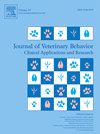Activity budgets of hedgehogs (Erinaceus europaeus) in rehabilitation centers: A pilot study
IF 1.3
3区 农林科学
Q4 BEHAVIORAL SCIENCES
Journal of Veterinary Behavior-clinical Applications and Research
Pub Date : 2025-05-01
DOI:10.1016/j.jveb.2025.04.011
引用次数: 0
Abstract
Erinaceus europaeus, the European hedgehog, was formerly very common but has recently suffered a decline across several European countries. There is a long-standing tradition of hedgehog rehabilitation centers across Europe with reported high rewilding success. Surprisingly, however, few data exist on the behavior of the animals while in these centers. To gain a better understanding of hedgehog behavior under husbandry conditions of rehabilitation, we documented the behavioral repertoires of four hedgehogs over a 48-hour period, including behavioral observations and quantification of food consumed and distances covered per day. Most of the hedgehogs' time was spent resting, comprising about 20 h in a 24-hour period. The majority of activity occurred at night and was spent feeding, followed by locomotion. Daily food consumption (of a dry cat kibble) ranged from 31 to 71 g of dry matter in 16–41 feeding bouts (1.1–2.6 g/bout, 2.4–3.8 min/bout). The hedgehogs covered a mean distance of 34–335 m per day, with a mean speed ranging from 0.12 to 0.25 km/h. Compared to data from free-ranging specimens, the hedgehogs spent less time active and covered less distance per day. No stereotypical behavior was observed. These findings suggest that for the aim of rehabilitation, husbandry conditions are adequate; for long-term husbandry, modifications that facilitate more locomotion and more foraging behavior would be required.
刺猬(Erinaceus europaeus)在康复中心的活动预算:一项试点研究
欧洲刺猬Erinaceus europaeus,以前是非常常见的,但最近在几个欧洲国家遭受了下降。欧洲各地的刺猬康复中心有着悠久的传统,据报道,它们的野生化成功率很高。然而,令人惊讶的是,关于动物在这些中心的行为的数据很少。为了更好地了解饲养条件下的刺猬行为,研究人员记录了4只刺猬在48小时内的行为特征,包括行为观察、每日食物消耗和行走距离的量化。刺猬的大部分时间都在休息,24小时内大约有20 小时。大多数活动发生在夜间,主要是进食,其次是运动。在16-41次喂养中,每天的食物消耗量(干猫粗粉)为31 - 71 g (1.1-2.6 g/次,2.4-3.8 min/次)。刺猬每天平均行走距离为34-335米,平均速度为0.12至0.25公里/小时。与自由放养的标本相比,这些刺猬每天活动的时间更少,行走的距离也更短。没有观察到刻板的行为。这些结果表明,为了达到恢复的目的,畜牧业条件是足够的;对于长期的饲养,需要进行改造,以促进更多的运动和更多的觅食行为。
本文章由计算机程序翻译,如有差异,请以英文原文为准。
求助全文
约1分钟内获得全文
求助全文
来源期刊
CiteScore
3.50
自引率
16.70%
发文量
107
审稿时长
325 days
期刊介绍:
Journal of Veterinary Behavior: Clinical Applications and Research is an international journal that focuses on all aspects of veterinary behavioral medicine, with a particular emphasis on clinical applications and research. Articles cover such topics as basic research involving normal signaling or social behaviors, welfare and/or housing issues, molecular or quantitative genetics, and applied behavioral issues (eg, working dogs) that may have implications for clinical interest or assessment.
JVEB is the official journal of the Australian Veterinary Behaviour Interest Group, the British Veterinary Behaviour Association, Gesellschaft fr Tierverhaltensmedizin und Therapie, the International Working Dog Breeding Association, the Pet Professional Guild, the Association Veterinaire Suisse pour la Medecine Comportementale, and The American Veterinary Society of Animal Behavior.

 求助内容:
求助内容: 应助结果提醒方式:
应助结果提醒方式:


